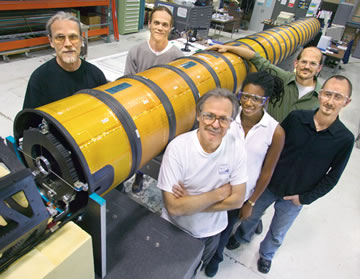
Exploring Matter and Energy in the Universe, page two
Superbright, uniform Type Ia supernovae are the best standard candles in the astronomical toolkit, measuring cosmic distances to a few percent accuracy. In 1998, after comparing the distances and redshifts of 42 painstakingly collected Type Ia supernovae, the international Supernova Cosmology Project led by Berkeley Lab’s Saul Perlmutter announced the accelerating expansion of the universe — driven by an exotic something comprising two-thirds the universe’s density and quickly christened “dark energy.”

Team members of the ATLAS project (left to right) Jon Wirth, Tom Johnson, Mario Cepeda, Alexis Smith, Neal Hartman, and Eric Andersson are pictured with the support structure for ATLAS' Pixel Detector. When completed, ATLAS's mission will include searching for the Higgs Boson, from which all other particles derive their mass.
Candidates for dark energy include the quantum-mechanical energy of the vacuum; fields dubbed “quintessence” whose strength varies with time; discontinuities in the fabric of space-time created in the Big Bang; or even extra-spatial dimensions. To distinguish among them, the expanding universe must be probed to greater distances and earlier times.
Lab scientists are attacking the problem from many angles. The international Nearby Supernova Factory based here will reduce the remaining uncertainties in Type Ia measurements through advanced spectroscopy of hundreds of supernovae only tens of millions of light-years distant, found by an automated sky search.
The SuperNova/Acceleration Probe, SNAP, is a collaboration of over 100 individuals from 15 academic and government institutions in the U.S., France, and Sweden, based at Berkeley Lab. Designed to measure thousands of distant supernovae in unprecedented detail, SNAP is the inspiration and a leading candidate for the Joint Dark Energy Mission announced by NASA and DOE in 2003, which ranks among the highest of DOE’s priority scientific facilities for the future.
SNAP has been described as “a camera with a telescope attached” — a two-meter reflector focusing a square degree of sky on a half-billion-pixel imager, hundreds of times the Hubble Space Telescope’s field of view. The imager’s most critical component is a rugged, radiation-resistant charge-coupled device (CCD) with extraordinary sensitivity to long wavelengths.
SNAP’s astronomical CCD is a descendant of the silicon vertex detectors built by Berkeley Lab for some of the world’s most important high-energy physics experiments, among them the CDF experiment at Fermilab, used to find and measure the top quark; the BaBar experiment at SLAC, which measures the asymmetric decay of B mesons; and the innermost pixel detector of the giant ATLAS experiment at the Large Hadron Collider (LHC), now under construction at CERN. ATLAS is hoping to find the Higgs Boson, from which all other particles derive their mass — and search beyond the Higgs for supersymmetric particles, extra dimensions of space, and even miniature black holes.